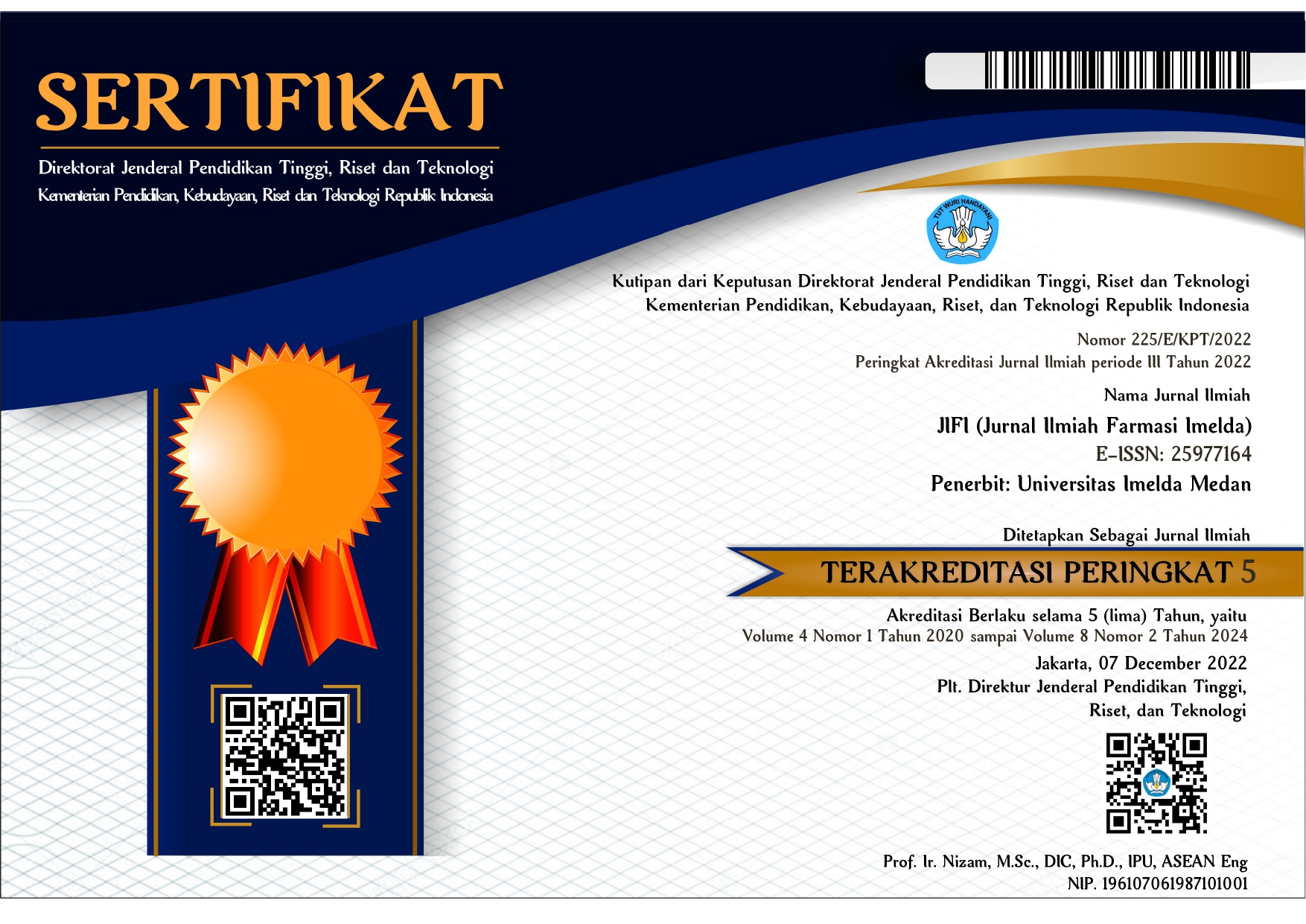EFEK EKSTRAK TANAMAN ASHITABA PADA KADAR SERUM ALKALIN FOSFATASE (ALP) PADA TIKUS YANG TERPAPAR LUKA BAKAR
DOI:
https://doi.org/10.52943/jifarmasi.v5i1.662Keywords:
Ashitaba Extrac, Serum Alkaline Phosphatase, Burn InjuryAbstract
Serum alkaline phosphatase (ALP) levels increases in burn tissue damage. Several bioactive compounds found in Ashitaba, are expected to reduce serum ALP levels and enhance the process of wound healing. This study aims to prove that administration of oral Ashitaba extract can reduce serum ALP levels in rats exposed to burn trauma. This study uses true experimental post-test control group design with a total of 20 Sprague dawley rats as samples. All samples were inflicted with 2nd degree burn wound and divided into 2 groups, treatment group (Ashitaba extract 300 mg/KgBW) and control group. Blood serum were analyzed for ALP levels on the 2nd, 8th and 14th days. Kinetic-IFCC method was used to find serum ALP levels. Data was analyzed using Mann-Whitney Test, paired T-test amd independence T-test. Scalded wound size was measured macroscopically over the course of 21 days to find contracture rate. In conclusion, Ashitaba extract is not proven to significantly reduce the serum ALP levels, increase contracture rate and enhance burn wound healing process. However, there was slight increase in contracture rate in treatment group as compared to control group. In addition, there was a lower ALP levels in treatment group as compared to control group in day 8.
References
[2] Garcia-Espinoza JA, Aguilar- Aragon VB, Ortiz-Villalobos EH, Garcia-Manzano RA, Antonio BA. Burns: Definition, Classification, Pathophysiology and Initial Approach, International Journal of General Medicine, 2017; 5:5, https://doi.org/10.4172/2327-5146.1000298.
[3] Tiwari VK. Burn wound: How it differs from other wounds?, Indian Journal of Plastic Surgery, 2012;45(2):364–373, https://doi.org/10.4103/0970- 0358.101319.
[4] Sehirli O, Sener E, Sener G, Cetinel S, Erzik C, Ye?en BC. Ghrelin improves burn- induced multiple organ injury by depressing neutrophil infiltration and the release of pro-inflammatory cytokines, Peptides, 2008;29:1231–40, https://doi.org/10.1016/j.peptides.2008.02.012.
[5] Wang S, Huang Q, Guo J, Local thermal injury induces general endothelial cell contraction through p38 MAP kinase activation, Acta Pathologica, Microbiologica, et Immunologica Scandinavica, 2014;122:832–41, https://doi.org/10.1111/apm.12226.
[6] Huang QB, Relationship between the endothelial barrier and vascular permeability after burns and its mechanism, Zhonghua Shao Shang Za Zhi, 2007;23:324–6. https://pubmed.ncbi.nlm.nih.gov/18396754/.
[7] Cotran RS, Abbas AK, Fausto N, Robbins SL, Kumar V, Robbins & Cotran: Patologia - Bases Patológicas das Doenças, 7. ed. Rio de Janeiro: Elsevier; 2005. 1592 p.
[8] Sarkar SD, Nahar L, Natural medicine: the genus Angelica, Current Medicinal Chemistry, 2004; 11: 1479-1500, https://doi.org/10.2174/0929867043365189.
[9] Caesar LK, Cech NB. A Review of the Medicinal Uses and Pharmacology of Ashitaba, Planta Medica, 2016 ;82(14):1236-45. https://doi.org/10.1055/s-0042-110496.
[10] Hisatome T, Wachi Y, Yamamoto Y, Ebihara A, Ishiyama A, Miyazaki H, Promotion of Endothelial Wound Healing by the Chalcones 4-hydroxyderricin and Xanthoangelol, and the Molecular Mechanism of This Effect, Journal of Sustainable Agriculture, 2017; 12: 25-33, https://doi.org/ 10.1262/jrd.2018-141.
[11] Maronpot RR, Toxicological assessment of Ashitaba Chalcone, Food Chemical Toxicology, 2015; 77: 111–19, https://doi.org/ 10.1016/j.fct.2014.12.021.
[12] Tietz NW, Rinker AD, Shaw LM. IFCC methods for the measurement of catalytic concentration of enzymes, Part 5, IFCC method for alkaline phosphatase, Journal of Clinical Chemistry and Clinical Biochemistry, 1983;21:731-748.
[13] Zhang XG, Li XM, Zhou XX, Wang Y, Lai WY, Liu Y, et al, The Wound Healing Effect of Callicarpa Nudiflora in Scalded Rats, Evidence Based Complement Alternative Medicine. 2019; 2019: 1-8, https://pubmed.ncbi.nlm.nih.gov/6655448/.
[14] Ghasemi A, Zahediasl S, Normality tests for statistical analysis: a guide for non-statisticians, International Journal of Endocrinol and Metabolism, 2012;10(2):486-489, https://doi.org/10.5812/ijem.3505.
[15] Kim TK. T test as a parametric statistic. Korean Journal of Anesthesiology, 2015;68(6):540-546, https://doi.org/10.4097/kjae.2015.68.6.540.
[16] Fay MP, Proschan MA. Wilcoxon-Mann-Whitney or t-test? On assumptions for hypothesis tests and multiple interpretations of decision rules, Statistics Survey. 2010;4:1-39, https://doi.org/10.1214/09-SS051.
[17] Adiga U, Adiga S, Biochemical Changes in Burns, International Journal of Research Studies in Biosciences, 2015; 3(7): 88-91, https://doi.org/10.1136/pgmj.48.557.144.
[18] Eming SA, Krieg T, Davidson JM. Inflammation in wound repair molecular and cellular mechanisms, Journal of Investigative Dermatology, 2007;127:514–525. https://doi.org/10.1038/sj.jid.5700701.
[19] Li J, Chen J, Kirsner R, Pathophisiology of acute wound healing, Clinics in Dermatology, 2007;25:9–18, https://doi.org/10.1016/j.clindermatol.2006.09.007.
[20] Hawkins, Denise, and Heidi Abrahamse, “How Should an Increase in Alkaline Phosphatase Activity Be Interpreted?” Laser Chemistry, 2007.1–10, https://doi.org/10.1155/2007/49608.
[21] Gonzalez AC, Costa TF, Andrade ZA, Medrado AR, Wound healing – A literature review, The journal Brazilian Annals of Dermatology, 2016;91(5):614–20, https://doi.org/10.1590/abd1806-4841.20164741.
[22] The Jackson Laboratory, How Much Blood Can I Take From A Mouse Without Endangering Its Health? eNews, 2005, https://www.jax.org/news-and-insights.
[23] Church D, Elsayed S, Reid O, Winston B, Lindsay R, Burn Wound Infections, Clinical Microbiology Reviews, 2006; 19(2), https://doi.org/10.1128/CMR.19.2.403-434.2006.









